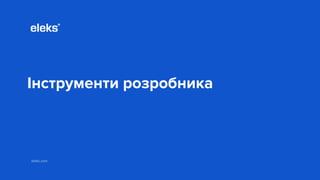Ad
Frontend basics
- 2. Поговоримо про Фронт-енд: що це? HTML CSS Інструменти розробника
- 7. HTML: HyperText Markup Language наслідується від SGML описується тегами (елементи в кутових дужках)
- 8. HTML != XML не чутлива до регістру змішані правила закривання
- 9. HTML: Document Object Model (DOM) ієрархія елементів також граф об’єктів
- 10. HTML документ • DOCTYPE – тип документа • html – опис документа • head – дані про документ • title – назва документа • body – візуальний вміст • h1 - заголовок • p - параграф
- 12. HTML: теги <div></div> - контейнер <a href=“http://someurl”></a> - посилання <img src=“path/to/image/” alt=“text” /> - картинка <ul><li></li>…<li></li></ul> - невпорядкований список <ol><li></li>…<li></li></ol> - впорядкований список <table><tr><td></td></tr></table> - таблиці
- 13. Теги Парні (<div></div>, <p></p>, <a></a>) Непарні (<img />, <br />, <hr />)
- 14. Теги Лінійні (<span></span>, <img />, <a></a>) Блокові (<div></div>, <p></p>)
- 15. HTML приклад сторінки (колись)
- 16. HTML приклад сторінки (тепер)
- 17. HTML5: теги header nav section footer article aside ...
- 18. HTML: форми
- 19. HTML форми: основні теги label input textarea button
- 21. eleks.com CSS
- 22. CSS: підходи Властивість style Тег style Каскадні таблиці стилів (CSS) – окремий файл
- 23. CSS: підключення до сторінки
- 24. CSS: правила
- 25. CSS: id, class селектори
- 26. CSS: селектори за атрибутами [disabled] вибирає усі елементи з атрибутом "disabled" [type='button'] вибирає усі елементи з типом a "button". [class~=key] вибирає усі елементи з класом "key" (але не e.g. "keyed", "monkey", "buckeye"). Еквівалентно .key. [lang|=es] вибирає усі елементи з атрибутом lang, що починається з “es” (ціле слово). Включає "es-MX". [title*="example" i] вибирає усі елементи з атрибутом title, що містить "example", ігноруючи регістр. a[href^="https://"] вибирає усі посилання з атрибутом href, що починається з https:// (не ціле слово). img[src$=".png"] вибирає усі картинки з атрибутом src, що закінчуються на “.png”
- 27. CSS: селектори псевдо-класів selector:pseudo-class { property: value; } • :link • :visited • :active • :hover • :focus • :first-child • :last-child • :nth-child • :nth-last-child • :nth-of-type • :first-of-type • :last-of-type • :empty • :target • :checked • :enabled • :disabled
- 28. CSS: селектори, що базуються на відношеннях Селектор Вибрані елементи A E Усі Е елементи, що є нащадками елемента А (діти, діти дітей…) A > E Усі Е елементи, що є прямими нащадками елемента А (тільки діти) E:first-child Будь-який елемент Е, що є першою дитиною свого батька B + E Будь-який елемент Е, що є наступним братом елемента В
- 29. CSS: box-model
- 30. CSS: position Static – значення по замовчуванню, елементи відображаються послідовно один за одним Relative – відображається як static, але зміщений зі своєї позиції Absolute – елемент відображається абсолютно відносно першого нестатичного предка Fixed – відображається як absolute, та не змінює позицію при скролі.
- 31. CSS: display Block Inline Inline-block …
- 32. CSS: float Left – елемент займає крайню можливу ліву позицію на лінії в якій він мав би з’явитись Right - елемент займає крайню можливу праву позицію на лінії в якій він мав би з’явитись Clear – змушує елементи з’являтись під плаваючими (floated) елементами
- 33. CSS: горизонтальне центрування для inline та inline-* для block
- 34. CSS: вертикальне центрування для block
- 35. CSS: flexbox
- 37. Chrome Developer Tools: DOM
- 38. Chrome Developer Tools: Network
- 39. Chrome Developer Tools: Sources
- 40. Chrome Developer Tools: Console
- 42. eleks.com Inspired by Technology. Driven by Value.
- 43. Useful https://habrahabr.ru/post/202408/ (Как с верстать веб-страницу. Часть 1) https://developer.mozilla.org/en/ (mozila developer network) http://caniuse.com/ (feature detection) https://www.sublimetext.com/ (text editor)
Editor's Notes
- #8: Теги деякі видимі деякі нє Head – метадані Body – вміст який бачить користувач
- #9: Тег скріпт повинен мати пару навіть якщо В середині нічого немає Img ніколи не має тіла
- #10: Елементи – для користувача ДОМ – для розробника
- #13: Header, footer, section, article, aside, nav
- #14: Парні непарні
- #15: Лінійні блокові
- #18: Header, footer, section, article, aside, nav
- #19: Комунікація з сервером Лейбли Метод, екшн Інпути Типи Атрибути
- #20: Комунікація з сервером Лейбли Метод, екшн Інпути Типи Атрибути
- #21: Комунікація з сервером Лейбли Метод, екшн Інпути Типи Атрибути http://wilder.azurewebsites.net/echo
- #31: Static, absolute, fixed, relative
- #32: Static, absolute, fixed, relative
- #33: float
- #34: float
- #35: float

























![CSS: селектори за атрибутами
[disabled]
вибирає усі елементи з атрибутом "disabled"
[type='button']
вибирає усі елементи з типом a "button".
[class~=key]
вибирає усі елементи з класом "key" (але не e.g. "keyed", "monkey", "buckeye"). Еквівалентно .key.
[lang|=es]
вибирає усі елементи з атрибутом lang, що починається з “es” (ціле слово). Включає "es-MX".
[title*="example" i]
вибирає усі елементи з атрибутом title, що містить "example", ігноруючи регістр.
a[href^="https://"]
вибирає усі посилання з атрибутом href, що починається з https:// (не ціле слово).
img[src$=".png"]
вибирає усі картинки з атрибутом src, що закінчуються на “.png”](https://image.slidesharecdn.com/frontendbasics-160531121618/85/Frontend-basics-26-320.jpg)



















































